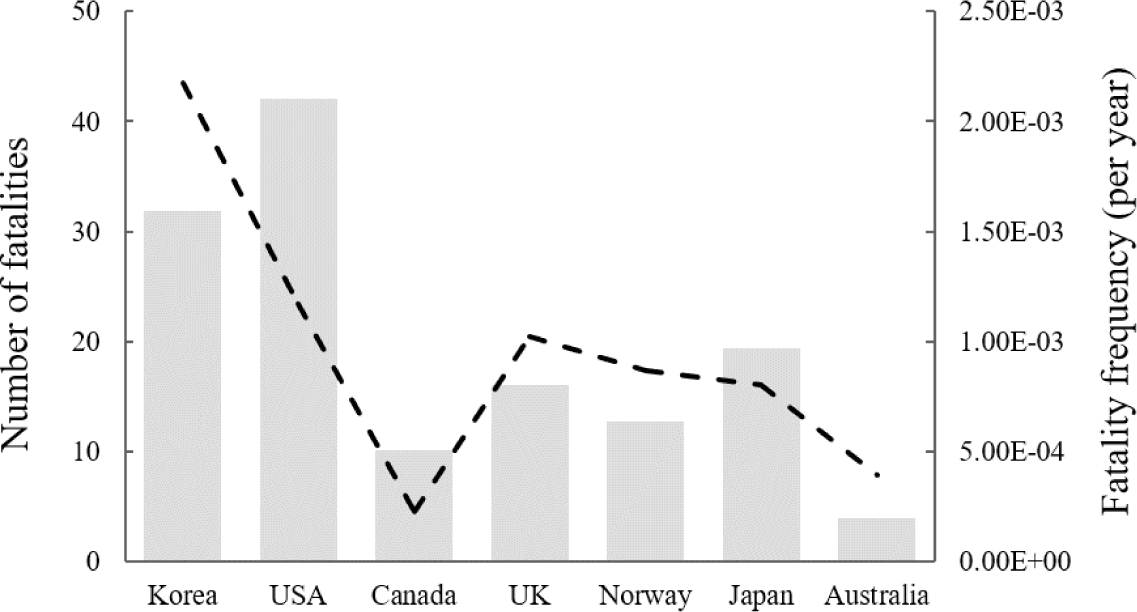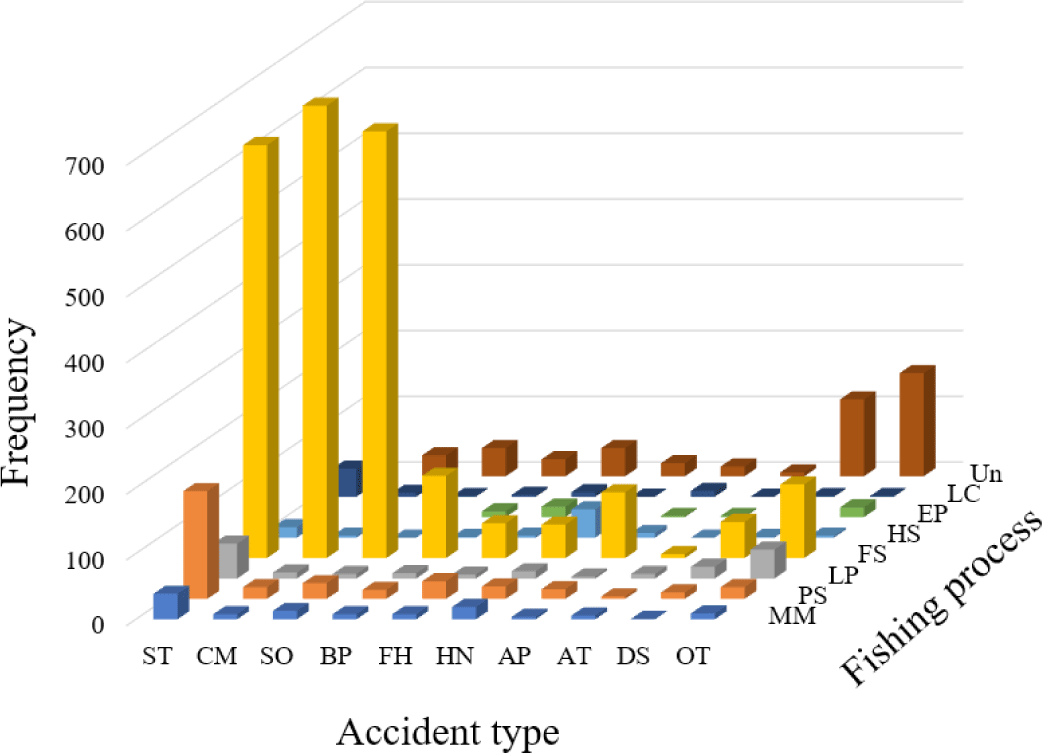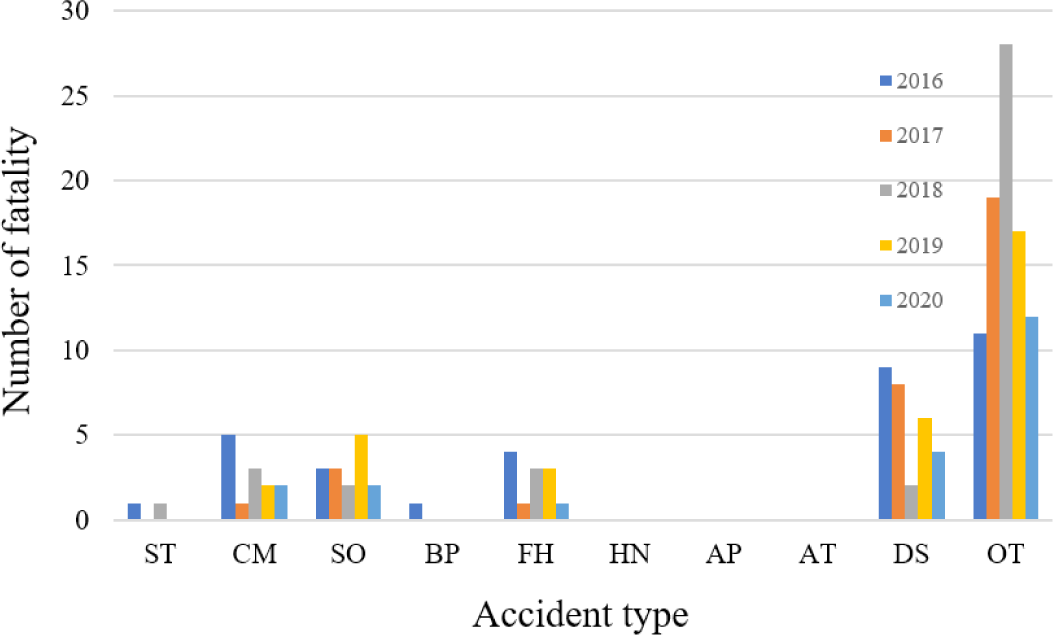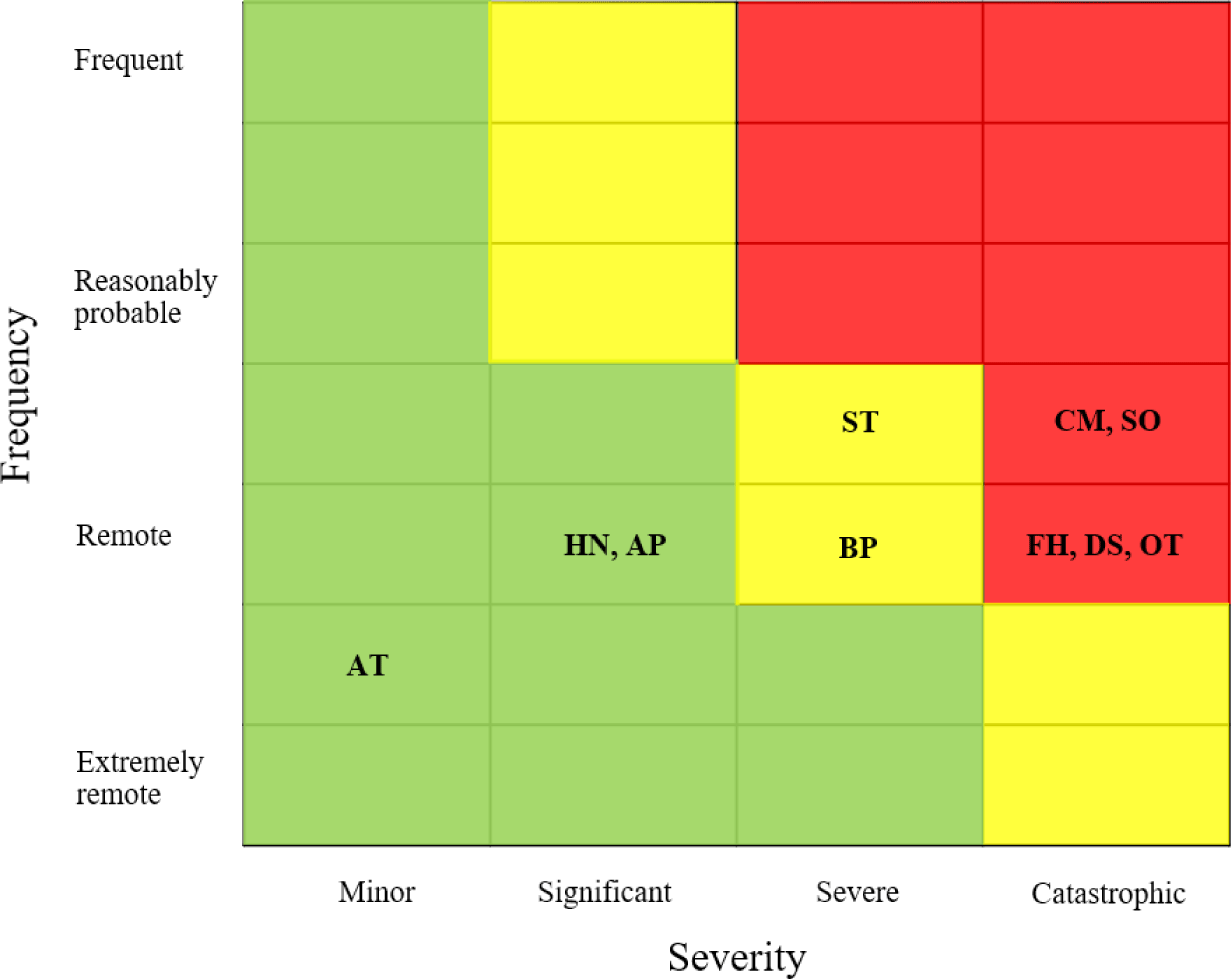Introduction
The Food and Agricultural Organization (FAO) reported that approximately 59.51 million people work in fishing and aquaculture, of which 38.98 million are employed as fishers (FAO, 2020). With the advancement in communication technology, if a fisher experiences an accident during fishing, healthcare support is available through the remote emergency healthcare system; however, as most fishing operations are conducted far from the shore, the fisher inevitably has to rely on fellow fishers until port entry. Fishing is therefore regarded as one of the most dangerous industries in many countries, alongside mining and forestry.
Gillnet fishing involves the use of drift or fixed gillnets to capture aquatic animals. A total of 12,694 gillnet fishing vessels were registered in South Korea in 2020, accounting for approximately 31.8% of all coastal fishing vessels (MOF [Ministry of Oceans and Fisheries], 2022). Meanwhile, despite the lower accident rates compared to purse seiner or stow net fishing, the frequency of accidents is higher in gillnet fishing owing to the high number of registered ships; thus, appropriate measures should be developed (Kim et al., 2014).
Previous studies on accidents related to fishing have compared the results of surveys and interviews collected at the ports of Geojin and Jumunjin on the east coast of South Korea with those obtained from other primary industries, and indicated that the high rate of accidents is due to inadequate safety awareness and low levels of protective gear or participation in safety public health education (Song et al., 2005). In addition, a survey investigating the status of occupation-related diseases indicated that musculoskeletal and digestive issues are the most frequently occurring problems afflicting those in the fishing industry, whereas factors with strong effects on the disease incidence are age, position, perceived health, and fatigue (Kim & Chang, 2006). Another study analyzing statements for accident compensation insurance payments by the National Federation of Fisheries Cooperatives (NFFC) indicated that the fatality associated with large purse-seine, large trawl, and stow net fishing on the coasts of South Korea, where fishing grounds cover large tidal ranges, was more than 20-fold that of the mean fatality in all industries. The main accident types reported during fishing are Struck by objects (SO) and Caught-in (CI) (Choi et al., 2019; Lee et al., 2015a, 2015b, 2016). In an overseas study on the risks of fishing the coasts of Norway, the risk was reported to be fairly low despite the high statistical values (Thorvaldsen, 2013), and a field survey on fishing in the US pointed out the need for safety education to improve the underestimated risks and safety awareness (Davis, 2012). In another survey on fishers in Texas, most were Asians with language barriers, and 60% regarded the risk of accident low. The study therefore suggested that an effective safety education program should be developed for these fishers (Levin et al., 2010). Another in-depth interview of people working on small ships along the coasts of North Carolina discussed the general practice and attitude to safety, specific safety measures, appropriate gear, and ship maintenance, and collaboration upon preparation to sail (McDonald & Kucera, 2007).
As previously described, studies on the safety of fishers in South Korea are generally via surveys investigating injuries and accident prevention. Although one previous study investigated the risk factors for fishers on coastal fishing vessels by analyzing statements of accident compensation insurance payments by the NFFC, there is a relative lack of studies on those that work on coastal fishing vessels, which account for approximately 60% of sea surface fishing in the region.
Thus, this study analyzed statistical data from occupational accidents to determine the level of safety on coastal gillnet fishing vessels in South Korea and identify the types of frequently occurring safety accidents during fishing, with an aim of improving safety management. The first goal was to determine the level of safety in gillnet fishery in South Korea and compare it with that of other countries, for which the following questions were asked: 1) What is the quantified level of risk for gillnet fishery in South Korea? 2) Is this risk level high or low compared to other countries? The second goal was to identify and analyze the types of accidents that occur in gillnet fishing, for which two questions were asked: 1) What types of accident have occurred in gillnet fishery in South Korea? 2) What is the frequency and severity of each type of accident?
To address these questions and draw conclusions, the present study is organized as follows: section 2 presents the methods used for data collection, statistical analysis, and the criteria used for risk assessment regarding accidents on gillnet fishing vessels. Section 3 presents an analysis of the frequency and severity of accidents under various criteria, and the risk was evaluated for each accident type. Lastly, section 4 presents the results in association with the previously set goals and questions, with discussion of the limitations and suggestions for future research.
Materials and Methods
The data used in this study were obtained from the census data covering 3,953 statements of accident compensation insurance payments related to gillnet fishing over the past 5 years (2016–2020) from the NFFC. The accident frequency and severity were analyzed by fishing process and accident type, and the obtained data were used to identify the level of risk associated with each fishing process. For duplicated statements of insurance payment for an identical accident according to Article 23, Paragraph 6 of the Act on Accident Compensation Insurance for Fishers and Fishing Vessels (repeated recuperation), only the first statement released after registration of the accident was included. The number of fishers used in calculating the accident frequency was based on the number of NFFC accident insurance holders.
To identify the risk factors that may affect those working on gillnet fishing vessels as a result of ship structure, facilities, or management, accidents were divided into several different types: falls from height (FH), slip and trips (ST), pressing (PV), bumping (BP), SO, contact with machinery (CM), collapse (CT), disease (DS), hazardous/noxious substance (HN), awkward posture (AP), abnormal temperature (AT), and other (OT), which includes oxygen depletion and suffocation (OD), fire and explosion (FE), and electrocution (EC). The included categories are based on the potential accidents on fishing vessels that are stated in the guidelines for recording and categorizing industrial accidents (the item regarding the contact with objects and facilities) from the Korea Occupational Safety Health Agency (KOSHA, 2016).
To quantify the level of risk in gillnet fishery, the accident/injury/fatality frequency and return period were calculated per ship and per fisher using the following equations:
The return period (ship year) in Equation (2) indicates the average interval between which accidents occur on a ship. For example, a return period of 2 years indicates that a particular ship has one accident every 2 years.
The frequency at which accidents occur on gillnet fishing vessels was analyzed by accident type after modifying for the number of ships in the MSC/Circ.1023 and the number of fishers, as shown in Table 1. The severity was analyzed using the number of fatalities and the mean insurance payment in the MSC/Circ. 1023, as shown in Table 2, where frequency (F) and severity (S) are used to assess the risk (R) by the type of accident (IMO, 2002, 2008).
Results and Discussion
The cumulative ship year for operational gillnet fishing vessels in South Korea during the 5-year period from 2016 to 2020 was 22,875, and the cumulative number of fishers was 72,970. A total of 3,895 accidents occurred during this period, as a result of which 3,794 fishers were injured and 159 fishers died. The respective details are presented in Table 3.
The frequency of accidents, both per ship and per fisher, was estimated based on the statistical data in Table 3, with the results presented in Table 4. The frequency of accidents/injuries/fatalities per ship was calculated using Equation (1) and the return period for each calculated using Equation (2). The same calculations were performed per fisher using Equation (3) and Equation (4), respectively.
As seen in Tables 3 and 4, 749–835 accidents occur on gillnet fishing boats each year, with the average accident frequency per fisher at 5.34 × 10–2 per year, indicating that accidents associated with gillnet fishing are 9.5 times that of the mean accident frequency of 5.7 × 10–3 per year for all industries in 2020 (KOSHA, 2022) and 4.5-fold that of the accident frequency per fisher for Japan in 2017 (1.2 × 10–2 per year) (MLIT, 2021). Notably, a direct comparison is difficult due to variations in the law and the targets studied, although the data are deemed adequate for an indirect comparison of accident frequency. For instance, the data in this study were obtained from the census data on which accident compensation insurance payments were determined based on the Act for Accident Compensation Insurance for Fishers and Fishing Vessels, while fatalities confirmed to have been caused by occupational accidents or disease and accidents causing ≥ 4 days of recuperation based on the Act on Industrial Accident Compensation Insurance were the target of the study in terms of frequency. In the case of Japan, the target was accidents that led to the death, disappearance, or suspension of work for ≥ 3 days for fishers, according to the Act on Fishers and Fisheries.
The average fatality for occupational accidents in gillnet fishery in South Korea was 2.18 × 10–3 per year, which is 2-fold that in the US (2011–2019) (NIOSH, 2022), the UK (1996–2005) (Roberts, 2010) and Australia (2016–2020) (AMSA, 2022), 3-fold that in Norway (1990–2011) (McGuinness et al., 2013) and Japan (2015–2020) (MLIT, 2022), and 10-fold that in Canada (2011–2019) (TSBC, 2021), indicating a considerably higher level of fatality compared to other countries. Details of the number of accidents and fatalities in South Korea and other countries are presented in Fig. 1.

The types of accident with the highest frequency were ST at 1,157 cases (29.3%), followed by CM at 774 cases (19.6%) and SO at 748 cases (18.9%); thus, the three most frequent accidents account for 67.8% of all accidents. Notably, ST, the most frequent type of accident, accounted for approximately 30% of all accidents, which suggested that active efforts should be made to reduce ST through activities such as washing decks clean after casting or hauling the net or processing fish and wearing boots that are specifically for fishing to prevent slipping on fiber-reinforced plastic decks. One case of ST occurred during ship loading at the port, and as ST does not solely involve simple slips and trips but also potential secondary injuries as a result of falling off the ship or colliding with the ship structures, adequate precautions need to be taken. Table 5 presents the number of injuries and fatalities by accident type. As the main target of this study was occupational accidents during fishing, marine accidents such as overturn, collision, and shipwreck were excluded from analyses and categorized as OT.
The accident frequency per ship and per fisher was estimated based on the statistical data in Table 5, with the results presented in Table 6. The frequency of accidents/injuries/fatalities per ship and the return period were calculated using Equation (1) and Equation (2), respectively, with the same calculations per fisher made with Equation (3) and Equation (4), respectively.
The frequency of accidents was highest during fishing at 2,457 cases (62.4%) and the second highest during the preparation to sail at 313 cases (7.9%). If the fishing process and accident type are considered simultaneously, the three most frequently occurring accident types were ST, CM, and SO, all of which occurred during fishing. Details of the current status of accident types as a result of the fishing process are presented in Fig. 2.

The severity of accident by type was estimated from the number of fatalities and the mean compensation payments, as shown in Fig. 3 and Table 7. The highest severity resulted from OT, as seen in Fig. 3, which includes the death and disappearance of fishers from accidents such as overturn, with 17.4 affected on average over a range of 11–28. The type with the second highest severity is DS, with an average of 5.8 and the third highest is SO with an average of 3.0. No fatality was found associated with the three accident types AT, BP, and HN.

The total insurance payments of approximately 87 million USD over the past five years comprises mean insurance payments of approximately 3,820 USD per gillnet ship and approximately 1,198 USD per fisher. The mean insurance payment, both per ship and per fisher, is mainly due to CM followed by ST and SO. Table 7 presents the total insurance and mean insurance payments by accident type.
In the field of industrial accident compensation insurance, severity generally indicates fatalities that are confirmed to have been caused by occupational accidents/diseases and accidents requiring ≥ 4 days of recuperation based on the Act for Industrial Accident Compensation Insurance. However, the number of recuperation days could not be determined from the data used in this study; hence, the mean accident compensation insurance payment was used in the analysis of severity by accident type.
Fig. 4 presents the results of the risk estimations for occupational accidents (R) using the frequency (F) and severity (S) for each accident type.

In Fig. 4, the frequency by accident type is divided into seven levels using the frequency index (FI) defined in Table 1. ST, CM, and SO are FI 4; FH, DS, OT, BP, HN, and AP are FI 3; and AT is FI 2. The severity is divided into the four levels defined in Table 2, with OT, DS, FH, CM, and SO considered catastrophic, the highest level, ST and BP considered severe; HN and AP considered significant; and AT seen as minor.
Hence, OT, DS, FH, CM, and SO are high risk accident types that demand immediate termination of operation and temporary emergency safety measures; ST and BP are medium risk operations that require the development of safety risk reduction measures during scheduled repair and maintenance; and HN, AP, and AT are low risk and necessitate only safety information and periodic safety education.
Table 8 presents the result of analyzing the occupational accidents that occur in gillnet fishing vessels according to the site of injury in fisher.
As shown in Table 8, the most frequent site of injury in the total 800 cases was the hand (n = 163, 20.4%), followed by the leg (n = 67, 8.4%), rib (n = 65, 8.1%), and shoulder (n = 64, 8.0%). The high proportion of other (n = 259, 32.4%) is because this category includes all insufficiently reported injuries and is based on the analyzed data describing secondary accidents that occurred through marine events such as collision, overturn, fire, and explosion. Injuries to the hand as the result of using knives or net haulers were most frequent, with shoulder pain and musculoskeletal disorders occurring frequently due to age and long hours of repeated activities that characterize the working environment associated with this type of fishing. The results are consistent with those of previous studies (Kim & Chang, 2006).
Conclusion
In this study, 3,953 accident compensation insurance payment statements that have been related to gillnet fishing in the past 5 years (2016–2020) in South Korea were analyzed to examine the level of risk and the accident types. The frequencies of accidents, injuries, and fatalities were estimated and the insurance payments calculated per ship and per fisher to identify the severity. In addition, an in-depth comparative analysis of fatal accidents was performed as the most severe occupational accidents in the industry and the results compared with those in other countries to assess the risk of gillnet fishing in South Korea.
The categories listed in the KOSHA guidelines for recording and categorizing industrial accidents were used to examine the types of accident that occur in the gillnet fishing industry. Ten potential accident types were identified and the accident frequency calculated per ship and per fisher for each type. The insurance payments were also analyzed by type to identify the severity of each accident. A risk assessment for each type of accident was then performed based on the data describing accident frequency and severity.
The following results were thus obtained for the original questions:
To answer the first question on the quantitative level of risk for gillnet fishing in South Korea, the accident frequency per ship was 1.73 × 10–1 per ship year and the insurance payments amounted to 3,819.56 USD per ship year. The accident frequency per fisher was 5.42 × 10–2 per year and the insurance payments amounted to 1,197.38 USD per year. Hence, the accident frequency was 9.5 times the mean accident frequency for all industries in South Korea, meaning that accident reduction is urgently required in the gillnet fishing industry of South Korea.
The second objective was to compare the risk of gillnet fishing in South Korea with that of other countries; the results indicate a fatality rate of 2.18 × 10–3 per fisher per year for gillnet fishery in South Korea, which is 10-fold that of Canada, 3-fold that of Norway and Japan, and 2-fold that of the USA, the UK, and Australia. The risk is therefore considerably higher in South Korea than it is in other countries, indicating the need to investigate the safety regulations and policies related to this type of fishing in other countries and compare the findings with the current status in South Korea.
To answer the final question, ST accidents were most frequent, followed by CM and SO, and these three categories account for 67.8% of the total accidents associated with gillnet fishing. Regarding severity, OT, which includes marine accidents such as overturn, showed the highest level, followed by DS and FH. Application of the method adopted by public health care and safety decision-making in the UK for risk assessment, which uses frequency and severity by accident type, indicates a high proportion of unacceptable risk across most accident types except AT, suggesting that improved safety measures are urgently required.
All quantitative indices obtained from analysis of the level of risk and accident types indicated the need for measures that can enhance the safety of gillnet fishery in South Korea. The diverse statistical data analyzed in this study could contribute as input data in a variety of studies aimed at improving safety in this industry.








